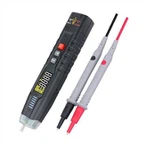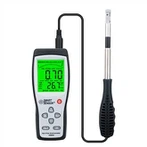Questions and answers regarding the use of digital multimeters
1. What is the buzzer function for?
Answer: The buzzer function is an additional function of the multimeter. It is generally set in the 2KΩ range. Generally, when measuring a line (or resistance) with a resistance value below 50Ω, the built-in buzzer will sound. This function is very useful in practice, and it can improve the work efficiency of measuring circuit continuity, which is an essential function for electronic maintenance.
2. Why does the digital multimeter fail to return to zero when it is short-circuited at the 200Ω range?
Answer: In the 200Ω range, due to the resistance of the line, the internal resistance of the instrument, and the contact point, it is normal to have some mantissas when shorted. Plates, tight contact points to reduce the value. In use, short circuit first, and write down the value, then subtract it in the measurement.
3. How to make sure the multimeter is good?
Answer: This is a relatively big question. It is a better way to try each function range. When testing, you must first find the testing source, but it is impossible for general users to prepare their own standard testing sources, so general testing can be measured by qualitative and quantitative methods. The basic solution is to find the detection source and use it according to the instructions.
4. How to proofread the multimeter?
Answer: The multimeter is the same as other measuring instruments. The manufacturer has adjusted it before leaving the factory. Therefore, if there is no obvious problem, please do not adjust it at will. The head of the current multimeter is generally a voltmeter, so when you want to calibrate other gears, you must first adjust the DC voltage gear. This gear is what the industry calls the basic gear. Every gear and function (except the resistance gear) may be inaccurate. Generally, a multimeter will set one potentiometer (such as DC voltage file) or multiple potentiometers (such as temperature file) for each function, and some potentiometers are not set (such as resistance file). It is easy to handle with a potentiometer, input the detection signal, and then directly adjust it; if there is no potentiometer, generally it will not be inaccurate, in case of inaccuracy, it may be caused by damage to the instrument or poor contact of the line.
5. How to judge (test) whether the DC voltage (DCV) of the multimeter is good?
Answer: When testing, we must first find the detection source. Because we are qualitative and a little quantitative, there are many detection sources available. There are household detection sources, 1.5V alkaline/carbon batteries (No. 1, No. 5/AA, 7/AAA), 1.2V rechargeable battery, mobile phone charger, power adapter, etc. When testing, turn the multimeter to the required DC voltage range, insert the test leads according to the instructions, connect the detection source, and read the reading on the LCD. As long as the measured value is around the nominal voltage, it will be fine. .






